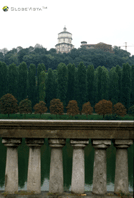
The Monte dei Cappuccini is a small hill which is located across the Po River and overlooks the city of Turin. The hill is home to a Capuchin church and convent.
From archeological diggings, the hill has revealed quite a unique past. During diggings, fossil seashells were unearthed, leading many to believe this small hill was once covered with an ocean, thousands of years ago.
During the 11th century, the hill became a strategic location, with a small fortified complex (Bastia) built to defend the wooden bridge to the city. During the 17th and 19th century this strategic location was held by the French, Spanish and Austrian-Russian troops, as it became the perfect location for artillery positioning, during the various wars of the region.
Church of Saint Mary of the Hill
Duke Carlo Emanuele I, acquired the Monte dei Cappuccini, in 1581 and transferred the land to the Capuchin Franciscan monks. The monks assigned the architect Giacomo Soldati to build a church dedicated to Saint Maurice but it was never completed.
In 1610, under a new architect (Ascanio Vitozzi) and a new name Santa Maria del Monte (The Church of Saint Mary of the Hill), construction of the church continued. Unfortunately, following the death of the architect, Vitozzi, work on the church slowed down but was eventually completed in 1656 under the direction of architect Carlo di Castamonte.
The Church, though simple in design, houses an altar by Carlo di Casellamonte, a marble throne by Benedetto Alfieri, paintings by Guglielmo Caccia & Giovan Battista Crespi and wooden statues carved by Stefano Clemente.
In 1884 a small funicular railway was built for the Universal Exhibition which led to a small square in the front of the church. The railway ceased with the onset of World War II and was never to be reopened.
In 1958 a piece of wrought iron fencing from the Lourdes Grotto was donated to the church and now resides in a small square overlooking Turin.
The Convent
The convent on the hill has a dark and at times, mysterious past. The convent became an important safe haven during the plague of the 1630s when Turin was virtually destroyed by the rapid spread of the ‘Black Death‘.
Ten years later, in 1640, the convent was to witness its darkest of days, when French troops massacred over 400 defenseless people, who had sought refuge at the convent.
Digging Up The Past
During some restoration work in the late 1980s workers uncovered a walled door, which led to a small room within the church. They also uncovered a grave dug in the uneven floor. Inside the grave was a skeleton, believed to be that of Father Cherubino Fournier of Maurienne who had died at the convent in 1609. His grave had long been forgotten, due mainly to the devastating plague that swept the area in 1630. All knowledge of the location of Father Fournier’s body was lost for nearly 400 years, denying him beatification.
Another accidental unearthing happened in the garden of the convent. Preparing to bury the ashes of an old monk in the garden, workers came across a preserved skeleton just below the surface. As it wasn’t the practice of the convent to bury monks in the garden, the only clues to the body in the garden, were the two ceramic pipe bowls which were found next to the body. Having dated the bowls to the 17th century, the conclusion was the body belonged to Count Filippo d’Aglie, a French Marechal de champ (Captain of His Majesty’s Guards). Filippo was famous for his love affair with the Duchess Christine of France and the widow of Duke Vittorio Amedeo I.Filippo was also known for directing, writing, and choreographing ballets for the Turin Court. Before his death in 1667, he requested that he be buried in a humble grave, in the garden of Monte dei Cappuccini convent.
